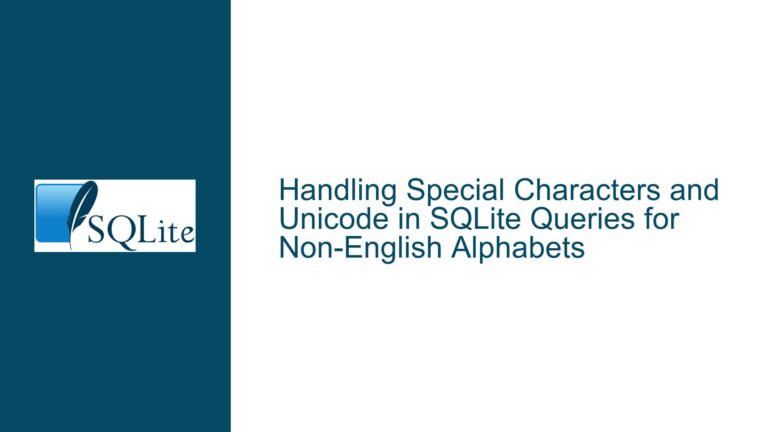Using Variables in SQLite: Techniques and Best Practices
Understanding SQLite’s Approach to Variables
SQLite, unlike some other database systems, does not natively support variables in the same way that procedural languages or even some other SQL dialects do. This can be a point of confusion for developers who are accustomed to using variables in SQL Server, PostgreSQL, or other databases. However, SQLite provides several mechanisms to achieve similar functionality, each with its own use cases and limitations. The core issue revolves around how to effectively use these mechanisms to simulate variable-like behavior within SQLite, particularly when dealing with repetitive tasks such as querying, updating, or inserting data based on specific values.
The discussion highlights several methods to achieve this, including the use of SQLite parameters, temporary tables, Common Table Expressions (CTEs), and the SQLite CLI’s .param command. Each of these methods has its own strengths and weaknesses, and understanding them is crucial for writing efficient and maintainable SQLite code. The primary challenge lies in selecting the right approach based on the specific requirements of the task at hand, whether it’s a one-off script, a complex query, or a series of operations that need to be performed repeatedly.
Exploring the Limitations and Workarounds for Variable Assignment in SQLite
One of the key limitations of SQLite is its lack of native support for variables within SQL statements. This is due to SQLite’s design philosophy, which emphasizes simplicity and minimalism. Unlike procedural SQL extensions like PL/SQL or T-SQL, SQLite does not provide a way to declare and use variables directly within SQL scripts. This can be particularly challenging when dealing with complex queries or scripts that require the reuse of certain values across multiple statements.
However, SQLite does offer several workarounds that can be used to simulate variable-like behavior. The most straightforward approach is to use SQLite’s parameter binding feature, which allows you to bind values to placeholders in your SQL statements. This can be done using the .param command in the SQLite CLI or by using parameterized queries in a programming language that interfaces with SQLite. Another approach is to use temporary tables to store values that need to be reused across multiple queries. This method is particularly useful when dealing with complex queries that require the reuse of multiple values or when the values need to be dynamically generated or modified.
Additionally, Common Table Expressions (CTEs) can be used to define temporary result sets that can be referenced within a query. This can be a powerful tool for simplifying complex queries and making them more readable. However, CTEs are limited to the scope of a single query and cannot be used to store values that need to be reused across multiple queries. Each of these methods has its own trade-offs, and understanding these trade-offs is crucial for selecting the right approach for your specific use case.
Step-by-Step Guide to Implementing Variable-Like Behavior in SQLite
To implement variable-like behavior in SQLite, you can follow these steps:
Using SQLite Parameters: The
.paramcommand in the SQLite CLI allows you to set and use parameters in your SQL statements. This is particularly useful for one-off scripts or when you need to reuse the same value across multiple queries. To use this method, you first need to initialize the parameter table using the.param initcommand. You can then set parameters using the.param setcommand and reference them in your SQL statements using the:paramnamesyntax. For example, you can set a parameter:XXXto the valueAmadand then use it in a query likeSELECT * FROM Bible WHERE Scripture LIKE '%' || :XXX || '%';. This method is simple and effective but is limited to the scope of the current session.Using Temporary Tables: Temporary tables can be used to store values that need to be reused across multiple queries. This method is particularly useful when dealing with complex queries that require the reuse of multiple values or when the values need to be dynamically generated or modified. To use this method, you first need to create a temporary table using the
CREATE TEMP TABLEstatement. You can then insert values into this table and reference them in your queries. For example, you can create a temporary tablesqlite_parameterswith columnskeyandvalue, insert the valuesAmad,N170, andDefinitioninto this table, and then reference these values in your queries using joins or subqueries. This method is more flexible than using parameters but requires more setup and can be more complex to manage.Using Common Table Expressions (CTEs): CTEs can be used to define temporary result sets that can be referenced within a query. This method is particularly useful for simplifying complex queries and making them more readable. To use this method, you can define a CTE using the
WITHclause and then reference it in your query. For example, you can define a CTEvarswith columnsXXX,YYY, andZZZand then reference these columns in your query. This method is limited to the scope of a single query but can be a powerful tool for simplifying complex queries.Using Parameterized Queries in a Programming Language: If you are using SQLite in conjunction with a programming language, you can use parameterized queries to bind values to placeholders in your SQL statements. This method is particularly useful when dealing with dynamic values or when you need to reuse the same value across multiple queries. To use this method, you first need to prepare your SQL statement with placeholders and then bind values to these placeholders using the appropriate API calls. For example, in Python, you can use the
sqlite3module to prepare a query with placeholders and then bind values to these placeholders using theexecutemethod. This method is highly flexible and can be used in a wide range of scenarios but requires knowledge of the programming language and its SQLite API.
By following these steps, you can effectively implement variable-like behavior in SQLite and overcome the limitations of its lack of native support for variables. Each method has its own strengths and weaknesses, and understanding these trade-offs is crucial for selecting the right approach for your specific use case. Whether you are working on a one-off script, a complex query, or a series of operations that need to be performed repeatedly, these techniques will help you write more efficient and maintainable SQLite code.






